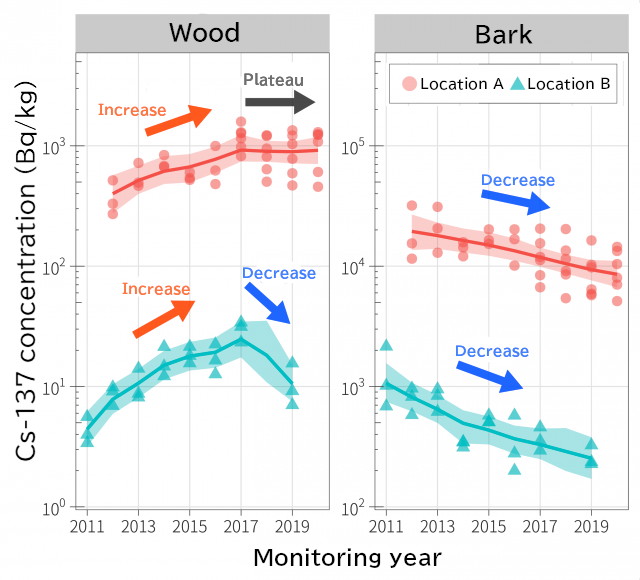Radioactivity Dynamics in forests
(2023)
QWhat kind of changes did radioactive cesium concentrations in wood and bark of trees contaminated by the nuclear accident go through over 10 years since the accident?
AThe Forestry and Forest Products Research Institute has been monitoring the concentration of radioactive cesium (Cs-137) in wood and bark of trees contaminated by the nuclear accident since one year after the accident, and conducted time series analysis to understand its change over 10 years since the accident. As a result, it was found that Cs-137 concentrations in wood increased for several years after the accident in some forests, but then the concentrations plateaued or changed to decrease in many forests. Meanwhile, Cs-137 concentrations in bark was decreasing in general, but the rate of reduction was lower in forests where trees were likely taking up a large amount of Cs-137 from the soil.
Radioactive cesium (Cs-137) that scattered by the accident at the TEPCO’s Fukushima Daiichi Nuclear Power Station fell over a large area in eastern Japan. Some of the fallout deposited onto the surface of trees, and the trees absorbed some of the deposits into their bodies. Meanwhile, Cs-137 fallout that fell onto the soil is continuously absorbed into trees through their roots. Wood produced in Fukushima and neighboring prefectures can be safely used in buildings without causing any external exposure issues. However, using as fuel (firewood, charcoal) or mushroom logs is limited to wood with extremely low Cs-137 concentrations to prevent internal exposure, taking into account possible biological accumulation and concentration. Also, a large amount of bark that is generated during production of wood can cause issues when using or disposing of it. For that reason, it is important to accurately ascertain and predict Cs-137 concentrations in wood and bark of trees in planning and making a decision on forest management and wood production.
Various research groups proposed models to predict Cs-137 in wood, but the reliability of their long-term predictions is poor: Cs-137 concentrations predicted for 50 years later vary by as much as 100 times between models. In addition, many models predicted that Cs-137 concentrations in wood would change from increasing to decreasing, but such a change had never been observed in actual samples. To improve the accuracy of prediction and to verify the appropriateness of models, it is extremely important to expand and analyze observation data.

Photographs Collecting a wood sample
In areas with low radioactive cesium (Cs-137) concentrations, a large amount of samples is required for measurement and trees are felled to collect samples. In areas with high Cs-137 concentrations, assuming monitoring for a longer period of time, wood cores (cylindrical samples) are collected.
Targeting cedar, cypress, konara oak, or Japanese red pine aged around 50 years, radioactive cesium (Cs-137) concentrations in wood and bark at a total of nine forests in Fukushima and Ibaraki prefectures were periodically measured over a period from 2011 to 2020, and their changes over time was analyzed using a dynamic linear model.
As a result, it was found that Cs-137 concentrations in wood consistently remained unchanged at two locations, decreased at two locations, and increased at one location since the accident. At the remaining four locations, the concentrations increased for several years after the accident, and then plateaued (e.g., location A in the figure below (left)) or changed to decrease (e.g., location B in the figure below (left)). Also at the location that showed an increasing trend, a sign of plateauing was observed.
Cs-137 concentrations in bark showed a decreasing trend at eight locations (e.g., locations A and B in the figure below (right)). However, the rate of reduction was lower at locations where trees were likely taking up a large amount of Cs-137 from the soil. In addition, as an exceptional case, Cs-137 concentrations did not decrease at all at one location.

Figure Change in radioactive cesium (Cs-137) concentrations in wood and bark over time (examples: 2 locations with konara oak samples)
The marks ◯ and △ indicate measured values, and the lines and bands indicate the median and 95% confidence interval of predicted trend, respectively.
(Note: The charts are different in the source literature as the analysis was performed excluding the effect of reduction by radioactive decay.)
The fact that radioactive cesium (Cs-137) concentrations in wood reached plateau or changed to decrease in many trees indicate that the amount of Cs-137 trees absorb from the soil has become similar to the amount of Cs-137 released by dropping leaves, dropping branches, or other means. In such a state, the movement of Cs-137 within the forest or trees stabilizes compared to the early stage after the accident, and the prediction is expected to become more accurate in the future. It is also worthy to note that the stabilized movement would allow more accurate evaluation of the transfer coefficient, an index of Cs-137 absorption characteristics of trees, than the early stage after the accident.
Meanwhile, the results suggested that Cs-137 concentrations in wood and bark may plateau in forests where trees absorb a large amount of Cs-137 from the soil. Therefore, it is important to keep an eye on the trend of Cs-137 concentrations as well as to exhaustively determine transfer coefficients at many more locations to elucidate the factors that govern the amount of Cs-137 absorbed into trees.
(Research results from the Forestry and Forest Products Research Institute and others. Reproduced from the website of the Forestry and Forest Products Research Institute (partly edited by JAEA))
Related articles
- I heard most of the forests would not be decontaminated. Does cesium remain in the forests?
- How does radioactive cesium in forests move from trees to the ground surface? 【Movement in throughfall, stemflow, and litterfall】
- How does radioactive cesium in forests move from trees to the ground surface? 【Movement as particulate and dissolved states】
